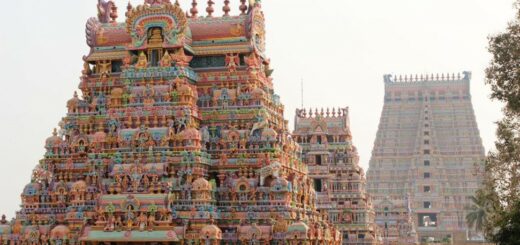Art & Culture: Indian Painting
Wall Painting
Introduction:
- Painting is one of the most delicate forms of art giving expression to human thoughts and feelings through the media of line and colour. Many thousands of years before the dawn of history, when man was only a cave dweller, he painted his rock shelters to satisfy his aesthetic sensitivity and creative urge.
- Among Indians, the love of colour and design is so deeply ingrained that from the earliest times they created paintings and drawings even during the periods of history for which we have no direct evidence.
- The earliest examples of Indian painting, that we found evidence of, are on the walls of some of the caves in the Kaimur Range of Central India, Vindhya Hills and some places in Uttar Pradesh.
- The paintings are primitive records of wild animals, war processions and hunting scenes. They are crudely but most realistically drawn. All these drawings bear a remarkable resemblance to the famous rock shelter paintings in Spain, which are presumed to be the work of Neolithic man.
- Leaving aside the wealth of materials of the Harappan Culture, the art of India, as a whole disappears from our sight for many years. This gap in Indian art cannot be filled satisfactorily as yet. However, we can learn a little of this dark epoch by reference to some of our old literatures belonging to the centuries before and after the birth of Christ.
- The Vinayapithak, a Buddhist text of circa 3rd – 4th century B.C. refers in many places to the pleasure houses containing picture halls which were adorned with painted figures and decorative patterns.
- Painted halls are also described in the Mahabharata and Ramayana, the composition of which in their original form is acknowledged to be of great antiquity. These early mural paintings may be assumed to be the prototypes of the carved and painted picture galleries of the subsequent periods of the Buddhist art, such as in the painted cave temples of Ajanta situated in Maharashtra State near Aurangabad.
- There are 30 caves chiseled out of the rock in a semicircular fashion. Their execution covers a period of about eight centuries. The earliest of them is probably out in the 2nd century B.C. and the latest is sometime in the 7th century A.D.
- The subject matter of these paintings is almost exclusively Buddhist, excepting decorative patterns on the ceilings and the pillars. They are mostly associated with the Jatakas, collection of stories, recording the previous births of the Lord Buddha.
- The compositions of these paintings are large in extent but the majority of the figures are smaller than life size. Principal characters in most of the designs are in heroic proportions.
- Centrality is one of the main features of the composition so that attention is at once drawn to the most important person in each scene. The contours of Ajanta figures are superb and reveal a keen perception of beauty and form.
- There is no undue striving after anatomical exactitude, for the drawing is spontaneous and unrestrained. The painters of Ajanta had realised the true glory of the Buddha, the story of whose life was employed here by them as a motif to explain the eternal pattern of human life.
- The stories illustrated here are continuous and elaborate presenting the drama of Ancient India enacted in the palaces of the Kings and in the hamlets of the common people equally engaged in the quest for the beautiful and spiritual values of life.
The Ajanta Paintings
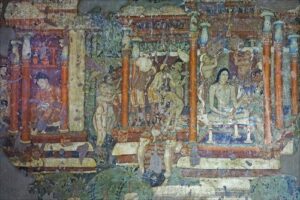
- The earliest paintings at Ajanta are in cave No. IX and X of which the only surviving one is a group on the left wall of cave X. This portrays a king with attendants in front of a tree decked with flags. The King has come to the sacred Bodhi tree for fulfilling some vow connected with the prince who is attending close to the king.
- This painting, though a fragmentary one shows a well developed art both in composition and execution which must have taken many centuries to reach this stage of maturity. There is a close resemblance in the representation of human figures with regard to their dress, ornaments and ethnical features between this painting and the sculptures of Amaravati and Karle of early Satavahana rules of circa 2nd century B.C.
- Another surviving painting at Ajanta, the enormously long continuous composition of Shaddanta Jataka along the right wall of the same cave (cave No.X) belonging to circa 1st century A.D. is one of the most beautiful but unfortunately one of the worst damaged and can only be appreciated at the site.
- We have little evidence of paintings of the next two to three centuries though it is certain that a good amount must have once existed. The next surviving and the most important series of Ajanta paintings are in cave No.XVI, XVII, II and I executed between the 5th and 7th century A.D.
- A beautiful example of this period is the painting which illustrates a scene of Jataka and commonly called ‘the dying princess’ in cave No.XVI painted in the early part of the 5th century A.D.
- ‘It is one of the most remarkable paintings of Ajanta as the movement of the line is sure and firm. This adaptation of line is the chief character of all oriental paintings and one of the greatest achievements of the Ajanta artists. Emotion and pathos are expressed here by the controlled turn and poise of the body and the eloquent gestures of the hands.
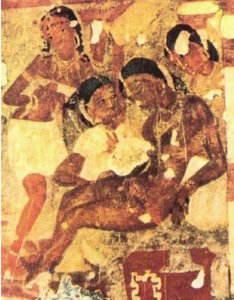
- There are flying apsaras in the cave No. X belonging to the late 6th century A.D. The rich ornamentation which was the characteristic of the period is beautifully portrayed in her turban decked with pearls and flowers.
- The scenes of Mahajanaka Jataka in cave No.1 are the best surviving examples of Ajanta paintings belonging to this period.
- In a scene Prince Mahajanaka – the future Buddha, discusses the problems of the kingdom with his mother, the queen who is shown in an extremely graceful pose and is surrounded by maids. A few of them with fly whisks are seen standing behind the king. In their discourse, the Prince probably is seeking his mother’s advice before beginning his march to reconquer his kingdom which has been usurped by his uncle.
- The painting of Bodhisatva Padmapani from cave I is one of the masterpieces of Ajanta Painting executed in the late 6th century A.D. In princely fashion he is wearing a crown adorned with sapphires, his long black hair falling gracefully.
- The strong direct drawing of the shoulder and arms is masterly in its unaffected simplicity. The eyebrows upon which depends much of the facial expression are drawn by simple lines. The way of holding the lotus ‘and the gestures of the hand, as shown here, is the greatest achievement of the Ajanta artists.
- The representation of one of the memorable events of Buddha’s life after enlightenment and which ranks among the best of the paintings at Ajanta, is in cave No.XVII painted probably in circa 6th century A.D.
- This represents Buddha’s visit to the door of Yashodhara’s abode in the city of Kapilavastu while she herself has come out with her son Rahula to meet the Great King. The artist had drawn the figure of the Buddha on a large scale, apparently to indicate his spiritual greatness as compared with ordinary beings for instance the representation of Yashodhara and Rahula looks very small by comparison.
- The head of Buddha is significantly inclined towards Yashodhara, showing compassion and love. The features of the face are obliterated but the eyes are clear and the meditative gaze suggests an absorption of mind in the spiritual. There is a halo around the Great King’s head and above it, a Vidhyaduri is holding an umbrella as a symbol of his sovereignty over the earth and heaven.Below, by the side of the door the figures of Yashodhara and Rahula are painted
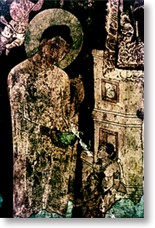
- A beautiful depiction of a feminine beauty as conceived by an Ajanta artist is apparently recognized as Maya Devi, the mother of the Buddha whose beauty the artist wanted to delineate without the restriction imposed by the incident of any story.
- Along-side these Buddhist paintings there are also a few Brahmanical figures of iconographic interest.
- Indra, a Hindu divinity, is depicted flying amid clouds together with celestial nymphs holding musical instruments. Indra is wearing a royal crown, pearl necklaces and in his girdle a sword and a dagger. The speed of his flight is suggested by the backward movement of pearl necklaces. This is from cave No.XVII and belongs to circa 6th century A.D.
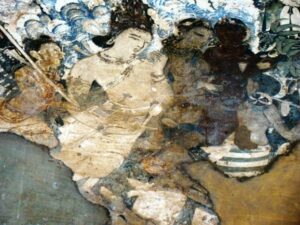
- Besides these religious paintings there are decorative designs on ceilings and pillars of these cave temples. Unlike the epics and continuous Jataka paintings there are complete designs within their squares.
- The whole flora and fauna in and around the artists world are faithfully portrayed but never do we find any repetition of form and colour. The artists of Ajanta, as if here suddenly emancipated from the dictum of the Jataka text, have given free reign to their perception, emotion and imagination.
- An example of ceiling decoration is from cave No.XVII and belongs to circa 6th century A.D. The pink elephant is from the same decorative painting ‘and can be seen in detail.
Bagh Caves Madhya Pradesh:
- The paintings from Bagh caves in Madhya Pradesh correspond to those paintings of Ajanta in cave No.I and II.
- Stylistically both belong to the same form, but Bagh figures are more tightly modelled, and are stronger in outline. They are more earthly and human than those at Ajanta. Unfortunately, their condition is now such that they can only be appreciated at the site.
Earliest Brahmanical Paintings:
- The earliest Brahmanical paintings so far known, are the fragments found in Badami caves, in cave No.III belonging to circa 6th century A.D. The so called Siva and Parvati is found somewhat well preserved. Though the technique follows that of Ajanta and Bagh, the modelling is much more sensitive in texture and expression and the outline soft and elastic.
- The paintings of Ajanta, Bagh and Badami represent the classical tradition of the North and the Deccan at its best.
Sittannavasal:
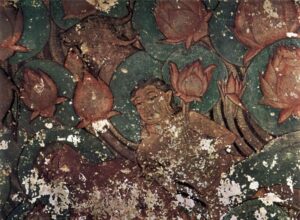
- Sittannavasal and other centres of paintings show the extent of its penetration in the South. The paintings of Sittannavasal are intimately connected with Jain themes and symbology, but enjoy the same norm and technique as that of Ajanta. The contours of these paintings are firmly drawn dark on a light red ground. On the ceiling of the Verandah is painted a large decorative scene of great beauty, a lotus pool with birds, elephants, buffaloes and a young man plucking flowers.
The Ellora Paintings:
- The next series of wall-painting to survive are at Ellora, a site of great importance and sanctity. A number of Hindu, Buddhist and Jain temples were excavated between the 8th and 10th centuries A.D. from the living rock. The most impressive of these, the Kailashnath temple is a free standing structure which is in fact a monolith. There are several fragments of painting on the ceiling of the different parts of this temple and on the walls of some associated Jain cave temple.

- The composition of the paintings at Ellora is measured out in rectangular panels with thick borders. They have thus been conceived within the given limits of frames that hold the paintings. The space, in the sense of Ajanta, therefore, does not exist at Ellora.
- So far as the style is concerned, Ellora painting is a departure from the classical norm of Ajanta paintings. Of course the classical tradition of modelling of the mass and rounded soft outline as well as the illusion of the coming forward from the depth is not altogether ignored.
- But the most important characteristic features of Ellora painting are the sharp twist of the head, painted angular bents of the arms, the concave curve of the close limbs, the sharp projected nose and the long drawn open eyes, which can very well be considered as the medieval character of Indian paintings.
- The flying figures from cave temple No.XXXII at Ellora belonging to mid-ninth century A.D. are beautiful examples of swift movement through clouds. Both the characteristics, the rounded plasticity of Ajanta modelling of classical period on the faces and the angular bends of the arms of medieval tendencies are well marked here. It is perhaps a product of the transitional period.
Tanjore Wall Painting:
- The most important wall paintings in South India are from Tanjore, Tamil Nadu. The dancing figures from Rajarajeswara temples of Tanjore belonging to early 11th century A.D. are beautiful examples of medieval paintings. The wide open eyes of all the figures are a clear negation of Ajanta tradition of half closed drooping eyes. But the figures are no less sensitive than the Ajanta figures, they are full of movement and throbbing with vitality.
- Another example of a dancing girl from Brihadeshwara temple of Tanjore belonging to the same period is a unique representation of swift movement and twisted form The face is shown in profile with pointed nose and chin while the eye is wide open. The rapturous figure of a dedicated temple dancer with vibrating contours is a true embodiment of sophistication in art and presents a charming, endearing and lovable feast to the eyes.
Hindpur Wall Painting:
- The last series of wall painting in India are from Lepakshi temple near Hindupur belonging to 16th century A.D. The paintings are pressed within broad friezes and illustrate Saivaite and secular themes.

- The colour scheme and the ornamentation are very pleasing and prove the highly sophisticated taste of Indian artists.
- The Boar hunt from the same temple, is also an example of two-dimensional painting which almost becomes characteristic of late medieval paintings either on wall or on palm leaf or paper.
Decline of Wall Painting:
- Thereafter a decline of Indian wall paintings began. The art continued into 18th-19th century A.D. in a very limited scale. During the period from 11th century A.D. onward, a new method of expression in painting known as miniature on palm leaves and paper; perhaps much easier and more economical had already begun.
- Some of the wall paintings of this declining period in the reign of Prince of Travancore in Kerala, in the palaces of Jaipur in Rajasthan and in the Rangmahal of the Chamba palace in Himachal Pradesh are worth mentioning. The Rangmahal paintings of Chamba deserve a special note in this connection as the National Museum is in possession of these early 19th century paintings in the original.
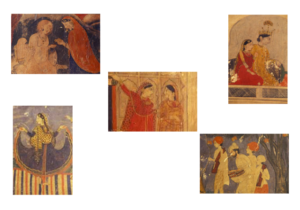 Technique and Process of wall painting:
Technique and Process of wall painting:
- It would be interesting and perhaps necessary to discuss the technique and process of making Indian wall paintings which has been discussed in a special chapter of the Vishnudharamotaram, a Sanskrit text of the 5th/6th century A.D.
- The process of these paintings appears to have been the same in all the early examples that have survived with an only exception in the Rajarajeshwara temple at Tanjore which is supposed to be done in a true fresco method over the surface of the rock.
- Most of the colours were locally available. Brushes were made up from the hair of animals, such as goat, camel, mongoose, etc.
- The ground was coated with an exceedingly thin layer of lime plaster over which paintings were drawn in water colours.
- In true fresco method the paintings are done when the surface wall is still wet so that the pigments go deep inside the wall surface. Whereas the other method of painting which was followed in most of the cases of Indian painting is known as tempora or fresco-secco. It is a method of painting on the lime plastered surface which has been allowed to dry first and then drenched with fresh lime water.
- On the surface thus obtained the artist proceeded to sketch out his composition. This first sketch was drawn by an experienced hand and subsequently corrected in many places with a strong black or deep brown line when the final drawing was added.
- After the painter had drawn out his first scheme in red, he proceeded to apply on this a semi-transparent terraverte monochrome, through which his outline could be seen. Over this preliminary glaze the artist worked in his local colours. The principal colours in use were red ochre, vivid red (vermilion), yellow ochre, indigo blue, lapis lazuli, lamp black (Kajjal), chalk white, terraverte and green.


